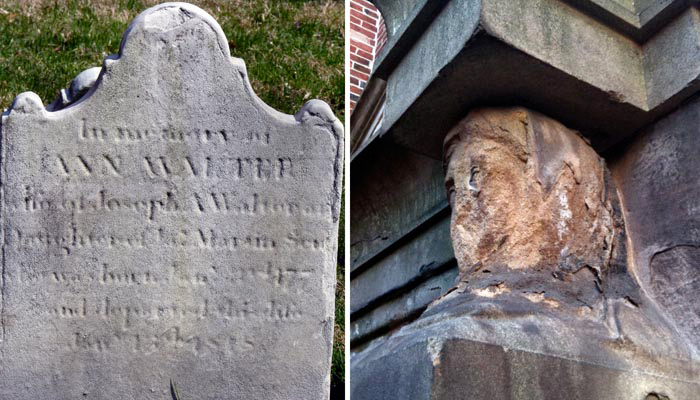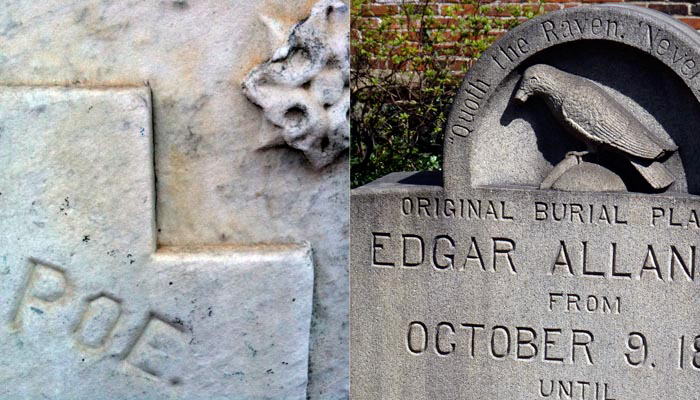Here For Evermore?
With Apologies to Edgar Allan Poe
The geologists have left the building. The Geological Society of America’s meeting in Baltimore is over and done, yet I find myself back in the same Baltimore hotel that just two days earlier was lousy with earth scientists. With colleagues from James Madison University and the U.S. Geological Survey I co-led a post-meeting field trip across the Appalachians, last night I delivered my charges back to Baltimore. Today, surrounded by bountiful spring weather I took to foot and explored the city. My travels brought me to Westminster Hall and the Burying Ground located just west of downtown, in the 18th and 19th century Baltimore’s leading citizens were laid to rest in and under stone monuments that befit their status. The Burying Ground’s most famous resident is Edgar Allan Poe whose death in 1849 still remains veiled in mystery. It is a mesmeric destination.
Once upon a midnight dreary, while on a long van ride to a geological meeting, weak and weary, W&M students and faculty passed time listening to a quaint and curious volume of Poe’s lore on tape. During that meeting my colleague Greg Hancock slipped a line or two from Poe into his professional talk, leaving the Tribe croaking with mirth. On occasion the geology faculty continues to call upon Poe for oratory nuggets when necessary. Insert “Now at this point you fancy me mad…”, “In some struggle with the grim phantasm…”, or “For the most wild yet homely narrative which I am about to…” at a scientific talk and heads will turn. Since we were orating just blocks from Poe’s final resting place it seemed only fitting to pay my respect.
The headstones, slabs, obelisks and sarcophagi are made from an array of intriguing stone, that alone would be enough to tempt a geologist into a bone yard, but the ravages of weather over two centuries testify to the efficacy of surface processes working at a historic and human time scale. The earliest headstones date from the late 1700’s, these are mostly cut from local marble quarried ~15 km north of Baltimore, they are simple Calvinist pieces. Marble is composed predominantly of calcite (CaCO3) a mineral that readily weathers via dissolution in Baltimore’s humid climate. Acid precipitation spawned by the industrial era has only increased the rate of weathering. Inscriptions carved in the marble are partially legible at best. By the mid-1800’s Baltimore’s wealthy were interred in vaults or beneath ornate obelisks cut from brownish-gray Cretaceous sandstone, reddish Triassic arkose, and gray Paleozoic granite obtained from quarries within 50 km of the city. The sandstone and arkose monuments are much despoiled, these stones are crumbing as individual clasts detach from the matrix or as entire sheets of rock exfoliate. A patina of urban pollution coats surfaces with a dark grime.

Left- Nearly unrecognizable carvings in a marble headstone from the late 1700’s. Right- Disintegrating statue (of a head) in sandstone at the entrance to a family vault erected in mid-1800’s.
How shall the burial rite be read? The saga of Poe’s burial site is, in itself, a tortuous tale. For years Poe was buried in an unmarked grave, by 1860 a marble headstone was ordered to honor the poet. A large marble block was transported to Baltimore by rail, but during the carving process in the rail yard a wayward train ran off its tracks and utterly destroyed the block. After the Civil War efforts resumed to honor Poe with a monument. It took a decade to secure funding, and in 1875 Poe was reinterred beneath a monument constructed on a square plinth of Maryland granite overlain by a 2-meter high rectangular block of carved Italian marble. Poe’s current gravesite is located just inside the Burying Grounds gate at the corner of West Fayette and North Greene Streets. Dissolution of the marble has noticeably softened the edges as well as the engravings during the past 135 years. By the 1930’s a bas-relief bust of Poe on the monument’s front was so weathered it was replaced with a cast bronze copy. Although more durable than marble, copper has leached from the bronze plaque and stained the marble surface a disquieting green hue.
In the further recesses of the cemetery a granite monument erected in 1913 denotes the original burial location of Poe, although nearly a century in age both the sculpted Raven and inscription remain sharp and crisp. The granite with its neatly interlocked feldspar and quartz and subordinate flecks of mica remains durable.

Left- Ornamentation and engravings on the south side of Poe’s marble grave show signs of significance chemical weathering (monument erected in 1875). Right- Granite monument marking the original Poe burial site (monument erected in 1913). Note the Raven, perched upon a bust of Pallas, seems little weathered.
In Shadow- A Parable Poe pinned “For indeed strange things shall happen, and secret things be known, and many centuries shall pass…”. As the centuries pass these monuments shall experience many strange things. Acidic rainwater, trickling over the stone’s surface, will liberate cations from anions and the rock will slowly dissolve, water will bond with minerals to produce new minerals whose properties will compromise the integrity of the rock itself, microorganisms will flourish on moist surfaces and wage chemical warfare on the rock structure. Some rocks will fare better than others, but shall these human monuments remain here for evermore?
Comments are currently closed. Comments are closed on all posts older than one year, and for those in our archive.




🙂